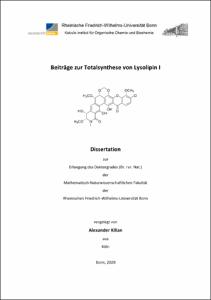Beiträge zur Totalsynthese von Lysolipin I

Beiträge zur Totalsynthese von Lysolipin I

| dc.contributor.advisor | Menche, Dirk | |
| dc.contributor.author | Kilian, Alexander | |
| dc.date.accessioned | 2020-06-12T13:13:58Z | |
| dc.date.available | 2021-06-15T22:00:19Z | |
| dc.date.issued | 12.06.2020 | |
| dc.identifier.uri | https://hdl.handle.net/20.500.11811/8409 | |
| dc.description.abstract | Die vorliegende Dissertation behandelt Studien zur Totalsynthese des Sekundärmetabolits Lysolipin I (1), eines der höchst-oxidierten, aromatischen Polyketide. Der heptazyklische Kern dieses potenten Antibiotiukums beinhaltet sowohl eine Xanthon- (A-C), als auch eine Isochinolineinheit (F+G), welche über ein zentrales Phenathrensystem (C-F) miteinander verbunden sind. Der siebte Ring (D) wird über eine Acetalbrücke zwischen dem Xanthon und dem Phenanthrenkern gebildet. Lysolipin I (1) weist sowohl gegen gram-positive als auch gram-negative Bakterienstämme biologische Aktivitäten auf und hemmt das Wachstum verschiedener Tumorzelllinien. Im Unterschied zu früheren Versuchen der Totalsynthese dieses Naturstoffs wurde Lysolipin I (1) bei der Syntheseplanung in die zwei Hauptstrukturmerkmale zerlegt, das Isochinolin als Südfragment 211 und das Xanthon, als Nordfragment 212, welche über eine flexible Kupplungsstrategie miteinander verknüpft werden können. Die Synthese des Südfragments wird in der Dissertation von Thomas Voigt und in der künftigen Dissertation von Maximilian Heinemann behandelt, während der Hauptfokus im ersten Teil dieser Arbeit auf der Synthese des Nordfragments liegt. Es werden verschiedene kurze, variable Syntheserouten, ausgehend von kommerziell erhältlichen Edukten, zum vorliegenden Xanthon 212 aufgezeigt. In einem zweiten Teil der Arbeit wird mit Studien zur Verknüpfung der Hauptfragmente über Sonogashira-Kupplungen die große Flexibilität der Syntheseplanung verdeutlicht, welche den Grundstein zur Synthese zahlreicher möglicher Analoga des Naturstoffs Lysolipin I (1) bilden. | en |
| dc.description.abstract | Contributions to the total synthesis of Lysolipin I
This thesis deals with studies towards the total synthesis of Lysolipin I (1). With its 11 oxygen atoms this polyketide is one of the highest oxidized secondary metabolites. Its heptacyclic aromatic core combines a xanthone (A-C) and an isoquinolinone subunit (F+G) which are condensed to a central phenanthrene system (C-F). The seventh ring (D) is built by an acetalbridge between the xanthone and the phenanthrene core. Lysolipin I exhibits potent biological activities against gram-positive and gram-negative bacteria. Furthermore, it also inhibits the growth of different tumor cell lines. As distinct from attempts for a total synthesis of this natural product in the past, Lysolipin I (1) was disconnected retrosynthetically in two structural moieties, the isochinolinone system as south- 211, and the xanthone as northfragment 212, which can be connected with a highly flexible coupling strategy. The synthesis of the southern fragment is discussed in the dissertation of Thomas Voigt and will be the topic of the dissertation of Maximilian Heinemann, while the main focus of this thesis is the synthesis of the northern fragment 212. Different short routes to yield the xanthone moiety from commercially available starting materials are presented. In a second part of the thesis studies towards the connection of the two main fragments via a Sonogashira-coupling illustrate maximum flexibility of the synthetic plan, which paves the way for a variety of potent analogs of the natural product Lysolipin I (1). | en |
| dc.language.iso | deu | |
| dc.rights | In Copyright | |
| dc.rights.uri | http://rightsstatements.org/vocab/InC/1.0/ | |
| dc.subject | Naturstoffe | |
| dc.subject | Polyketide | |
| dc.subject | Totalsynthese | |
| dc.subject | Xanthon | |
| dc.subject | Sonogashira | |
| dc.subject | natural products | |
| dc.subject | total synthesis | |
| dc.subject | xanthone | |
| dc.subject.ddc | 540 Chemie | |
| dc.title | Beiträge zur Totalsynthese von Lysolipin I | |
| dc.type | Dissertation oder Habilitation | |
| dc.publisher.name | Universitäts- und Landesbibliothek Bonn | |
| dc.publisher.location | Bonn | |
| dc.rights.accessRights | openAccess | |
| dc.identifier.urn | https://nbn-resolving.org/urn:nbn:de:hbz:5-58657 | |
| ulbbn.pubtype | Erstveröffentlichung | |
| ulbbnediss.affiliation.name | Rheinische Friedrich-Wilhelms-Universität Bonn | |
| ulbbnediss.affiliation.location | Bonn | |
| ulbbnediss.thesis.level | Dissertation | |
| ulbbnediss.dissID | 5865 | |
| ulbbnediss.date.accepted | 15.05.2020 | |
| ulbbnediss.institute | Mathematisch-Naturwissenschaftliche Fakultät : Fachgruppe Chemie / Kekulé-Institut für Organische Chemie und Biochemie | |
| ulbbnediss.fakultaet | Mathematisch-Naturwissenschaftliche Fakultät | |
| dc.contributor.coReferee | Höger, Sigurd | |
| ulbbnediss.date.embargoEndDate | 15.06.2021 | |
| ulbbnediss.contributor.gnd | 1235752445 |
Dateien zu dieser Ressource
Das Dokument erscheint in:
-
E-Dissertationen (4420)




